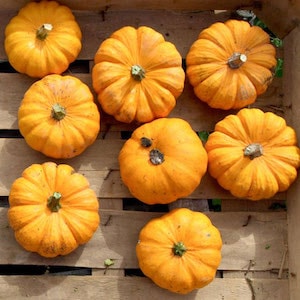What to do in your allotment in October
Written by Lee Senior
Autumn is the season of mists and mellow fruitfulness, and it’s well and truly in full swing. There’s less to harvest as our plants slow down in response to the shorter days, and the grass is covered by dew which is increasingly reluctant to clear apart from the sunniest days.
Many allotment holders grow pumpkins for Halloween – turning them into glowing orange lanterns is a fun activity for all the family, including adults! Pumpkins are easy to grow and will drape over compost bins or fences or even climb up sturdy trellis. Keep an eye on the weather and harvest before the first frost if you’re hoping to store your gourds.
October is a good time of year to take stock, assess what worked and perhaps what didn’t, and begin to plan for next year. Good record-keeping helps you keep track of successes and failures. I like to look back through my notes whenever I get a chance – apparently I’m often torn between leaving my late-ripening sweetcorn to enjoy another day of sun or rushing to rescue it from frostbite at this time of year! Happy growing!
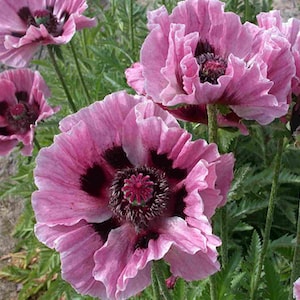
Image: Papaver Manhattan
Allotment flowers in October
- Autumn-sown sweet pea seeds can be started off during late October. They’re best sown in a cold greenhouse and kept under glass over winter for planting out in spring.
- Lavender seeds can also be sown now and treated in the same way as sweet peas.
- Plant spring flowering bulbs like daffodils and crocus for bright displays next year.
- The Autumn crocus (Colchicum) comes into flower in autumn as its name suggests. The plants are unusual as the flowers appear on leafless stems, and the leaves develop after the flowers have faded.
- Sow phacelia and fried egg plant seeds ready for next year. These flowers attract beneficial pollinators to the plot.
- The first proper frost will see dahlias blackened. When this happens, cut the foliage hard back to several centimetres from the tubers before digging them up. Dry the tubers off before overwintering them is a frost-free place, perhaps a garage or outbuilding.
Allotment vegetables in October
- Get your autumn-planting garlic sets in as soon as you can. The ‘Lovers Autumn Collection’ is a great idea as it contains four varieties suitable for autumn planting. Choose a hardneck type like ‘Kingsland Wight’ if you live somewhere very cold.
- Throughout the month, continue to plant out your overwintering onions and shallots in well-drained soil or raised beds. Cover the sets with netting until they establish roots, to stop the birds digging them out.
- Clear the tops from your spent beans, peas and sweetcorn plants. If you cut the long stems at the base and lay them on the soil, they act as a weed suppressing mulch. Add them to the compost when they turn from green to brown.
- Protect your cabbages, sprouts and broccoli plants with nets to keep the birds off.
- Sow leaf salad ‘Winter mix’ in a cold frame for fresh leaves in the coming months. There’s still time to sow winter lettuce too – I’m a fan of Cos ‘Winter Density’.
- Rocket ‘Scorpion’ can be sown this month and grown to maturity on a windowsill or in an unheated greenhouse. The hot mustardy flavour adds punch to salads!
- Sow hardy spring onion ‘White Lisbon’ in a cold frame, or in containers or grow bags in the greenhouse, to harvest through the winter and into early spring.
- The middle of the month is a good time to sow a crop of overwintering broad beans. ‘Aquadulce Claudia’ can be sown in root modules, seed trays or pots for an early crop in late spring. Simply grow the beans on in a cold frame, or plant outside in December if you’re lucky enough to have well-drained soil, in a sheltered location. The beans cope with several degrees of frost.
- October is the month to start sowing cabbage ‘F1 Mozart’, pea ‘Douce Provence’ and cauliflower ‘F1 Seoul’ to overwinter under cloches or in the cold frame. They’ll give you extra early crops next year.
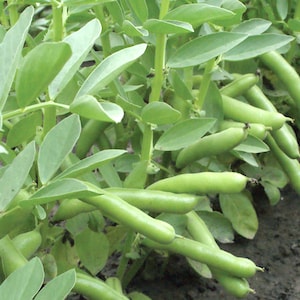
Image: Broad Bean – De Monica
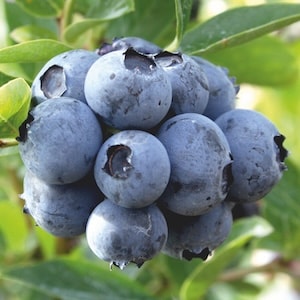
Image: Blueberry ‘Duke’
Allotment fruit in October
- October is the perfect month for moving fruit bushes and trees, and for planting new bare root fruit trees and soft fruit bushes. Their roots benefit from the warmth that remains in the soil before winter frosts. Avoid planting into frozen or waterlogged soil.
- If you intend to grow fig trees, I recommend planting them in large containers in fertile, rich soil and compost. The containers will restrict the rampant roots and encourage the trees to crop in future years. They can be planted out during autumn.
- Use a testing kit to see the pH of your soil before planting blueberries. They like acidity, so if your soil is alkali, grow them in a pot with ericaceous compost.
- If you have acidic soil, blueberries are a must-have on any allotment. They’re easy, reliable and delicious eaten straight off the bush. The plants are also stunning in autumn and the fiery red colour of the leaves is as good as anything you will find.
- Late autumn is the ideal time to plant out a new strawberry bed in well-drained soil. The sweet tasting ‘Marshmello’ is a great choice.
- October and November are good months to plant out new rhubarb crowns. Allow new crowns to get established in the first year and wait until the second year to harvest them. Alternatively divide your established clumps of rhubarb to produce more crowns and free up your older plants.
Crops to harvest in October
- Harvest your pumpkins and squashes this month for carving and storing.
- Sweetcorn should now be ripe – make sure you harvest before the first frosts hit.
- October is the peak apple harvesting season. I eat windfall apples straight away before the rot sets in, if they’re not too badly bruised. Good quality maincrop apples can be stored for a few weeks in a dark, frost-free location.
- Pears are often ready to pick this month too. It can be tricky to know when to harvest, but the best time is just before they’re fully ripe. Check that they’re firm and swollen and look out for a subtle colour change of the skin of the fruit.
- Beetroot, carrots and chard are all in season.
- The last of the maincrop potatoes should be dug up as soon as possible to avoid slug and wireworm damage as well as the increasing risk of rot in the wet autumn soil.
- Florence fennel should be harvested before any frost damage.
- Early varieties of leeks should be harvested before the onset of harsh weather as they are less hardy than the winter types
- Make sure you’ve harvested all of your summer crops and give your onions, shallots and garlic plenty of time to dry before storing.
- Healthy sweet pepper and cucumber plants will carry on a little longer until they are finally cut down by cold, frosty weather conditions.
- If you have any unripened tomatoes, take the fruit off the vine and bring them indoors to ripen. If you have a large quantity, try making green tomato chutney.
- In the greenhouse and polytunnel, tomatoes will continue to ripen for a little longer. Remove spent foliage from the plants and stop all new shoots so the plant diverts its energies towards developing and ripening any immature fruit.

Image: Crab Apple Red Sentinel
General October allotment jobs
- Keep on top of weeding as the beds are exposed to light when crops are cut back.
- Sow green manure seeds on empty beds to keep the soil covered over winter. This puts nitrogen back into the soil and prevents run-off in heavy rain.
- It’s time to take down pea and bean wigwams and frames.
- Sort out your composting area as it’s a great time to add prime fodder to your pile.
- Find a local source of horse manure. Use an empty bed to rot a pile down for use next year.
- Try planting a native bare root hedge on your allotment for wildlife. An edible hedge could give you a niche crop of crab apples, sloes and hawes to make jellies and jams.
- Stay off the soil when the ground is wet. Walk on broad flat planks if you need access to avoid compacting the soil.
Planning ahead
- Get in as much allotment time after work as possible before the clocks go back later in the month.
- Order in plant protection gear to prevent frost damage during the winter months.
- Invest in a cold frame for your plot if you haven’t already got one. They’re a great way to protect young crops from the worst of the winter weather.
- It’s time to start thinking about next year. Make a list of what worked and what didn’t.
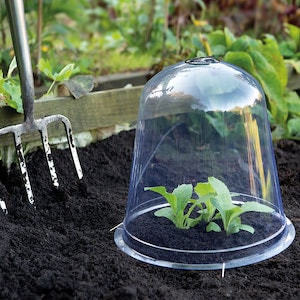
Image: Bell Cloche
Suttons Seeds recommend these areas which may also be of interest.
- Previous month: What to do in your allotment in September
- Next month: What to do in your allotment in November


